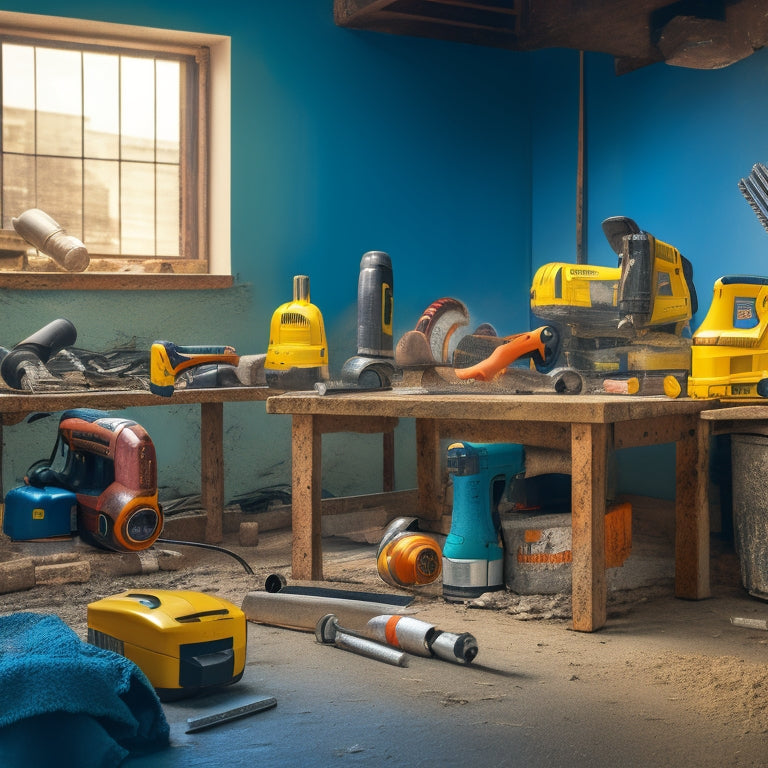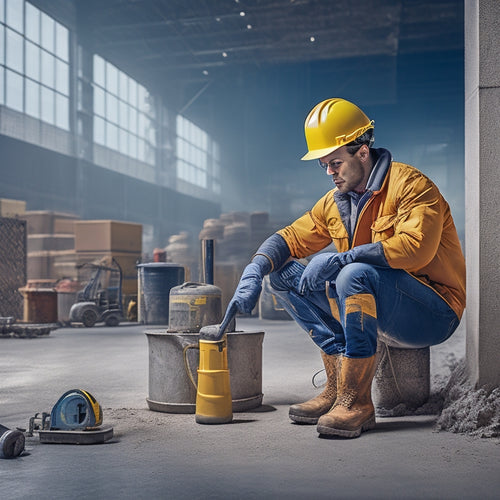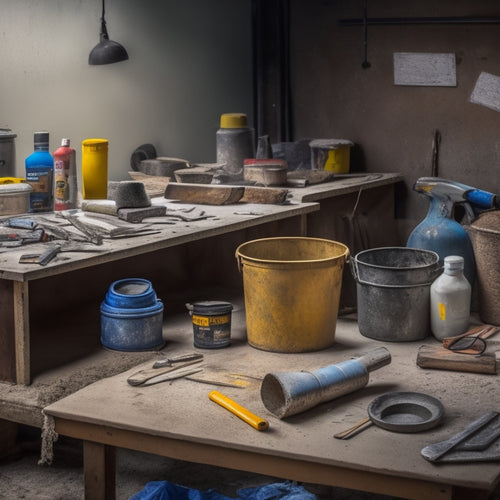
Essential Power Tools for Concrete Block Construction
Share
When building with concrete blocks, you'll need a range of power tools to cut, drill, mix, and finish the blocks to guarantee a strong and durable structure. For cutting and core drilling, choose diamond-coated blades and core drill bits that match the block type and density. Drilling and mixing equipment, such as rotary hammers and high-torque mixers, are also essential. Additionally, invest in block alignment, leveling, and edging tools, like laser levels and joint cleaners, to guarantee precise spacing and a strong bond between blocks. With the right tools, you'll be well on your way to building a sturdy concrete block structure that meets your project's requirements, and there's more to explore to master the craft.
Key Takeaways
- Diamond-coated and masonry blades are ideal for cutting solid concrete blocks, while hollow block cutters are recommended for hollow blocks.
- Reliable drills, such as rotary hammers and hammer drills, are necessary for anchors and inserts, and powerful mixers ensure concrete density.
- Laser levels, straightedges, and block alignment gauges aid in maintaining consistent block patterns and precise spacing and alignment.
- Angle grinders, die grinders, and rotary hammers remove excess material, while specialized tools like concrete planers and scarifiers smooth surfaces.
- Mortar pumps and reliable mixers are essential for transporting and preparing mortar efficiently, improving workflow and reducing downtime.
Concrete Block Cutting Essentials
Concrete Block Cutting Essentials
When preparing for concrete block construction, having the right cutting tools is crucial to guarantee accurate and efficient work. You'll need to choose the right tool for the specific concrete block type you're working with, as different blocks require different cutting techniques.
For instance, solid concrete blocks, hollow concrete blocks, and insulated concrete blocks each demand distinct cutting approaches. Your cutting tool selection will depend on the block's density, size, and shape. A diamond-coated saw blade or a masonry blade are ideal for cutting solid concrete blocks, while a hollow block cutter is better suited for hollow blocks.
Insulated blocks, on the other hand, require a specialized cutting tool designed specifically for their unique composition. Mastering various cutting techniques, such as scoring and snapping, or using a circular saw, will also guarantee precision and speed.
Drilling and Mixing Tools
As you've mastered the art of cutting concrete blocks with precision, it's time to focus on preparing the blocks for laying and bonding.
Drilling and mixing tools are vital for this stage of concrete block construction. You'll need a reliable drill to create holes for anchors, inserts, or other fastening systems. Choose from various drill types, including rotary hammers, hammer drills, or right-angle drills, depending on the specific task and substrate.
For mixing, you'll require a powerful mixer that can handle the density of concrete. Look for a mixer with a high-torque motor and a sturdy gearbox to guarantee efficient mixing.
Mixing techniques are essential to achieving the right consistency and avoiding air pockets. Use a mixing paddle or trowel to combine the concrete mix, and avoid over-mixing, which can lead to a weak bond.
With the right drilling and mixing tools, you'll be able to prepare your concrete blocks for a strong and durable bond.
Block Laying and Leveling
When laying concrete blocks, you'll need tools to guarantee accurate alignment and precise leveling.
Block alignment tools, such as laser levels and straightedges, help you maintain a consistent block pattern and prevent costly mistakes.
Block Alignment Tools
You'll need a set of specialized tools to guarantee accurate block alignment, which is critical for a structurally sound and visually appealing concrete block construction project. Misaligned blocks can lead to structural weaknesses, uneven surfaces, and costly rework.
To ascertain precise block spacing and alignment, you'll rely on tools like block alignment gauges, spirit levels, and laser levels. These tools enable you to establish and maintain accurate alignment techniques throughout the construction process.
Block alignment gauges, for instance, help you achieve consistent block spacing by providing a precise reference point for each course of blocks. Spirit levels and laser levels, on the other hand, ascertain that blocks are perfectly level and plumb, respectively.
Accurate Leveling Methods
A solid foundation relies on precise leveling, and that's where your block laying and leveling skills come into play. You'll need to guarantee that every block is perfectly aligned and level to prevent structural issues down the line. To achieve this, you'll require accurate leveling methods.
Laser leveling is a game-changer in concrete block construction. It allows you to project a level line or plane across the entire surface, guaranteeing that your blocks are perfectly aligned. This technology is especially useful when working on large projects or complex layouts.
For smaller areas or tighter spaces, spirit levels are still an essential tool. These precision instruments enable you to check the levelness of individual blocks or small sections of the wall.
When combining laser leveling with spirit levels, you'll achieve unparalleled accuracy. By using these tools in tandem, you'll be able to identify even the slightest deviations from the desired level, making adjustments on the fly.
With precise leveling, you'll build a solid foundation that will support the weight of your structure, guaranteeing a safe and durable concrete block construction.
Grinding and Smoothing Tools
As concrete block construction reaches its final stages, grinding and smoothing tools take center stage to refine the surface, removing imperfections and creating a uniform finish.
You'll need the right tools to achieve a smooth, even surface that's free of bumps, ridges, and other defects.
When it comes to grinding techniques, you'll rely on angle grinders, die grinders, and rotary hammers to remove excess material and smooth out rough spots. These tools are designed for heavy-duty use, so you can tackle even the toughest concrete surfaces with confidence.
For smoothing methods, you'll turn to specialized tools like concrete planers, scarifiers, and trowels. These tools help to further refine the surface, removing minor imperfections and leaving a smooth, even finish.
Mortar Mixing and Pumping
Your mortar mixing and pumping equipment plays a critical role in concrete block construction, guaranteeing the right consistency and flow of mortar to lay blocks efficiently and effectively. You need a reliable and efficient mixer that can handle various mortar types, from traditional to specialty mixes. When selecting a mixer, consider the type of project, mortar requirements, and the number of blocks to be laid.
Different mixing techniques are required for different mortar types. For instance, a slow-speed mixer is ideal for mixing polymer-modified mortars, while a high-speed mixer is better suited for traditional cement-based mortars. You should also consider the mixing capacity, as it directly impacts your productivity. A larger mixing capacity means you can mix more mortar in a single batch, reducing downtime and increasing your overall efficiency.
Investing in a mortar pump can considerably improve your workflow. These pumps can transport mortar to hard-to-reach areas, reducing labor costs and increasing your laying speed.
When choosing a mortar pump, look for one that can handle high-pressure applications and has a durable, corrosion-resistant design. By selecting the right mortar mixing and pumping equipment, you can guarantee a successful concrete block construction project.
Block Splitting and Breaking
When you're working with concrete blocks, you'll inevitably need to break or split them to fit specific dimensions or accommodate irregularities.
You'll encounter two primary block breaking methods: mechanical and manual, each suited to specific situations and requiring distinct tools.
In concrete block demolition, you'll need to select the right approach and equipment to efficiently break apart existing structures without compromising safety or structural integrity.
Block Breaking Methods
Frequently, concrete block construction projects require breaking blocks to fit around obstructions, achieve precise dimensions, or create unique architectural features. As you work on your project, you'll need to employ effective block breaking methods to achieve the desired results.
When it comes to block splitting techniques, you have several options:
-
Hydraulic breaking methods: These involve using hydraulic-powered tools, such as hydraulic splitters or hydraulic breakers, to apply immense force to the block, causing it to split or break.
-
Wedge and shims: This method involves placing a wedge in a pre-drilled hole and using shims to apply pressure, slowly splitting the block.
-
Hand-held breakers: These tools use a hammering action to break the block, often used for smaller blocks or in areas where access is limited.
Concrete Block Demolition
Concrete block demolition, also referred to as block splitting and breaking, is a vital aspect of concrete block construction projects. You'll need the right tools and techniques to efficiently and safely demolish concrete blocks.
Demolition techniques vary depending on the block's size, type, and condition. For instance, you can use a hammer drill with a demolition bit to break up smaller blocks, while larger blocks may require a pneumatic or electric breaker.
When selecting a demolition tool, consider the block's density, hardness, and any reinforcement it may have. You'll also need to take safety precautions seriously, wearing protective gear like gloves, safety glasses, and a dust mask.
Guarantee a stable working environment by clearing the area of debris and tripping hazards. Always follow the manufacturer's guidelines for tool operation and maintenance to prevent accidents.
Remember to plan your demolition strategy in advance, taking into account the structural integrity of the surrounding area.
Edging and Joint Cleaning
You're about to lay the groundwork for a sturdy structure, and that means meticulously preparing the concrete blocks for bonding. Edging and joint cleaning are vital steps in this process, as they guarantee a strong and durable bond between the blocks.
Proper edging techniques and joint maintenance can make all the difference in the structural integrity of your construction project.
To achieve ideal results, you'll need the right power tools for the job. Here are three essential tools to take into account:
-
Joint Cleaner: A joint cleaner is a specialized tool designed to remove dirt, debris, and old mortar from between the blocks. This guarantees a clean surface for new mortar to adhere to.
-
Edger: An edger is used to create a clean, angled edge on the blocks, allowing for a stronger bond between them. This is particularly important for corner blocks, where a strong bond is imperative.
-
Wire Brush: A wire brush is a versatile tool that can be used to clean and prepare the blocks for bonding. It's particularly effective at removing dirt and debris from the surface of the blocks.
Core Drilling and Sawing
When core drilling and sawing concrete blocks, you'll need the right tools to get the job done efficiently and accurately.
You'll require core drill bits that can handle the density and hardness of concrete, as well as saw blades specifically designed for cutting through this unforgiving material.
Core Drill Bits
Precision is key when creating openings in concrete blocks, and core drill bits are the go-to tools for this task.
You'll need core drill bits that can handle the demands of concrete block construction, providing accurate and efficient results.
When it comes to core drill applications, you'll want to take into account the following factors:
-
Drill speed and pressure: Adjusting drill speed and pressure guarantees ideal performance and extends the life of your core drill bits.
-
Bit selection: Choosing the right core drill bit for the job is vital; think about the type of concrete, the size of the opening, and the desired finish.
-
Core drill maintenance: Regularly inspect and maintain your core drill bits to prevent wear and tear, and to guarantee consistent results.
Saw Blades Selection
As you move on from creating precise openings with core drill bits, selecting the right saw blades for core drilling and sawing becomes essential to achieve efficient and accurate cuts in concrete blocks.
You'll need diamond blades specifically designed for cutting through concrete, as they're the most effective and longest-lasting option. When choosing a diamond blade, consider the type of concrete you're working with, the desired cut speed, and the blade's lifespan.
For wet cutting, look for blades with a segmented or turbo rim design, which help to reduce heat buildup and prevent blade damage. Wet cutting also reduces dust and debris, making it a safer and more efficient method.
Additionally, consider the blade's bond strength, which affects its ability to cut through different types of concrete. By selecting the right diamond blade for your concrete block construction project, you'll be able to make precise, efficient cuts that meet your project's demands.
Tamping and Compacting Tools
Tamping and compacting tools are the unsung heroes of concrete block construction, ensuring that freshly laid blocks settle firmly into place and that the entire structure stands strong.
You'll need these tools to achieve the necessary density and stability in your concrete block construction project.
When it comes to tamping techniques, you'll want to invest in the right tools to get the job done efficiently. Here are three essential tamping and compacting tools you should consider:
-
Plate Compactors: These powerful tools use a flat plate to compact soil and gravel, ensuring a stable base for your concrete blocks.
-
Tamping Rammers: Designed for smaller areas, tamping rammers are perfect for compacting soil and gravel in tight spaces.
-
Hand Tamper: A manual tool for small-scale compaction, hand tampers are ideal for areas inaccessible to larger machines.
Finishing and Polishing Tools
Once you've laid and compacted your concrete blocks, it's time to focus on the finer details. This is where finishing and polishing tools come into play.
You'll need a variety of tools to achieve a smooth, even finish on your concrete blocks. A concrete grinder is essential for removing imperfections and rough spots. With its rotating discs, it can quickly smooth out surfaces, preparing them for further polishing.
For a high-gloss finish, you'll need a polishing machine with progressively finer abrasives. These machines use polishing techniques to remove scratches and hazing, leaving a reflective surface.
Don't forget a dustless vacuum to contain debris and dust during the polishing process. Finally, apply a concrete sealer to protect your blocks from the elements and add a layer of durability.
With these finishing and polishing tools, you'll be able to add the finishing touches to your concrete block construction project, ensuring a professional-looking result.
Frequently Asked Questions
What Type of Protective Gear Should I Wear on a Concrete Block Site?
When working on a construction site, you should wear protective gear that meets strict safety guidelines, including a hard hat, safety glasses, earplugs, dust mask, steel-toed boots, and gloves to guarantee you're fully equipped with the right protective equipment.
Can I Use a Hammer Drill for Concrete Block Construction Projects?
Like a master sculptor chiseling away at raw stone, you'll uncover the perfect hole with the right hammer drill. Yes, you can use a hammer drill, but choose the correct type - rotary, SDS, or demolition - and master techniques like controlled pressure and slow, steady strokes.
How Do I Prevent Concrete Dust From Affecting My Power Tools?
When working with concrete, you'll want to prioritize dust control to protect your power tools; regularly clean air vents, use a vacuum with a HEPA filter, and perform routine tool maintenance to prevent dust buildup and prolong their lifespan.
Are There Any Specific Storage Requirements for Concrete Block Tools?
As you wrap up a long day on the job site, you can't help but wonder: what's lurking in the shadows, waiting to sabotage your tool's performance? Proper tool maintenance begins with storage solutions that shield your gear from the elements, ensuring peak power when you need it most.
Can I Rent Power Tools for Concrete Block Construction Projects?
You can rent power tools for concrete block construction projects, considering tool rental as a cost-effective option, especially for infrequent or one-time uses, but weigh the rental duration and costs against purchasing and maintenance expenses.
Conclusion
As you construct your concrete block masterpiece, remember that having the right tools is like having a perfectly tuned orchestra - each instrument plays a crucial role in creating a harmonious whole. From cutting and drilling to mixing and pumping, every tool is essential to the rhythm of your work. With these power tools in your arsenal, you'll be able to conduct a symphony of construction, building a strong and durable structure that will stand the test of time.
Related Posts
-

10 Best Tools for Sealed Concrete Flooring on Budget
When starting on a sealed concrete flooring project on a budget, you'll need to prioritize essential tools without sa...
-

3 Best Tools to Buy for Concrete Repair Online
When buying tools for concrete repair online, you'll want to research multiple retailer options to find the best prod...
-

Why These Tools Are Crucial for Concrete Patio
You're about to commence on a concrete patio project, and having the right tools is vital to achieving professional-l...


